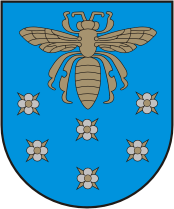 Alternate names: Varėna [Lith], Orany [Rus, Pol], Aran [Yid], Varēna [Latv], Oran, Warna, Worany, Waranii, Variena, Russian: Ораны. אַראַן-Yiddish. 54°13' N, 24°34' E, 18 miles W of Eišiškes (Eshishuk), 24 miles ESE of Alytus (Olita), 44 miles SW of Vilnius (Vilna). Shtetlink.
Alternate names: Varėna [Lith], Orany [Rus, Pol], Aran [Yid], Varēna [Latv], Oran, Warna, Worany, Waranii, Variena, Russian: Ораны. אַראַן-Yiddish. 54°13' N, 24°34' E, 18 miles W of Eišiškes (Eshishuk), 24 miles ESE of Alytus (Olita), 44 miles SW of Vilnius (Vilna). Shtetlink.
Słownik Geograficzny Królestwa Polskiego (1880-1902), VII, pp. 571-572: "Orany" #1.
The town grew during the second half of the 19th century with the construction of a railway. 1897 population census: 2,624 with 1473 Jews. Varena was severely damaged during WWI when many houses were burnt. Many left the town. In 1923, 407 people with 70 farmsteads lived in Varena. After the war, the demarcation line went along the Merkys River divided the town between Poland and Lithuania. Lithuania had Varena I (in Alytus uezd and a rural district center) and Poland got Varena II. The majority of Jews stayed in the Lithuanian part. In 1930, from three Jewish synagogues with approximately 600 families before the war, only seventy families and one synagogue restored in 1922 remained . Of three schools, only one remained. The Volksbank, established in 1920, had a one million lita turnover in 1929. During the inter-war period, Varena Jews had fourteen shops, a carton factory, and a bookshop. Some emigrated during the inter-war years. [March 2009]
CEMETERY: Located in the Jewish section of old Varena on a street with many homes, the cemetery is in good condition with over 150 tombstones standing and readable. The very old have sunk into the ground. Most of the stones seem to face the road as do a metal fence with a gate and sign. The fence is in good condition except in the back where it looks as if someone has cut and rolled it apart. (This is strange because at this place the land drops off.) There are many trees growing in this cemetery approximately 68 yards deep and 272 yards long. Submitted by This email address is being protected from spambots. You need JavaScript enabled to view it., Dayton, Ohio [date? ]
Cemetery information. [September 2010]
MASS GRAVE: German troops occupied Varena on June 26 , 1941. During the first day, the communists were persecuted. The populace were threatened with capital punishment for disobedience to the occupying government. A curfew was imposed. All Jews were ordered to register at the Police Station at 8 a.m. every morning. Soon, they were ordered to wear the yellow Star of David. At first, they thought that they were to be taken for labor, but in the early days of September, local police and white-bands forced the Varena Jews into the synagogue for several days. On September 10, 1941, the Chief of Alytus Security, his deputy, and 30 to 40 shooters came to Varena to join the local collaborators, who made the Jews undress to underwear and drove them in the direction of Druckūni village. The townspeople of the town were ordered to stay at home with closed curtains. The Jews were taken to the former Csarist Army grounds and gunned down in two trenches in the forest. Several from Varena took part in the shooting of 831 Jews (541 men, 141 women and 149 children). Only the minister of Varena, Jonas Gylys, expressed open protest when on the eve of the massacre, he asked the Varena police chief to let him visit the Jews kept in the synagogue. The reply was negative, but Gylys went anyway to comfort and console them. The guards drove him away. After the execution, Gylys openly and severely condemned the killings from the pulpit on September 14 saying, "the innocent people were beaten by the Lithuanians in uniforms ,who also pushed old people and pregnant women. They also shed innocent blood in Varna forest. The victims suffered as Christ suffered from the Jews. And they already looted their property without waiting for the blood to dry". (P. Biržys-Akiras source) In 1942, Parson Gylys was moved from Varena. In August and September 1941, 6,165 Jews were killed in Alytus and its environs although the real number of victims must have been higher since Jews killed as communists and Soviet activists during the first days and weeks of the war were not included in this count. Several dozen Jews from Jieznas sent to Prienai (Marijampole County) were killed with the Jews from Prienai, making 8,030 deaths more likely.[March 2009]
Forest of Vidzgiris, near Alytus; 74-75; pic. # 48-52; forest of Marcinkonys between lake Kaslinis and railway station; 182-183; pic. # 329-330; near Varena's forest about 1.5 km from town, at the road to village of Druckunai; 182; pic. # 327-328 US Commission for the Preservation of America's Heritage Abroad
